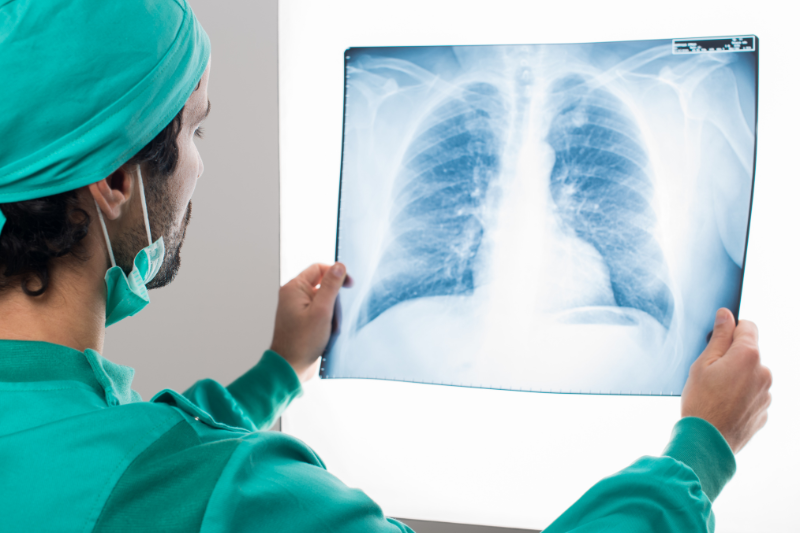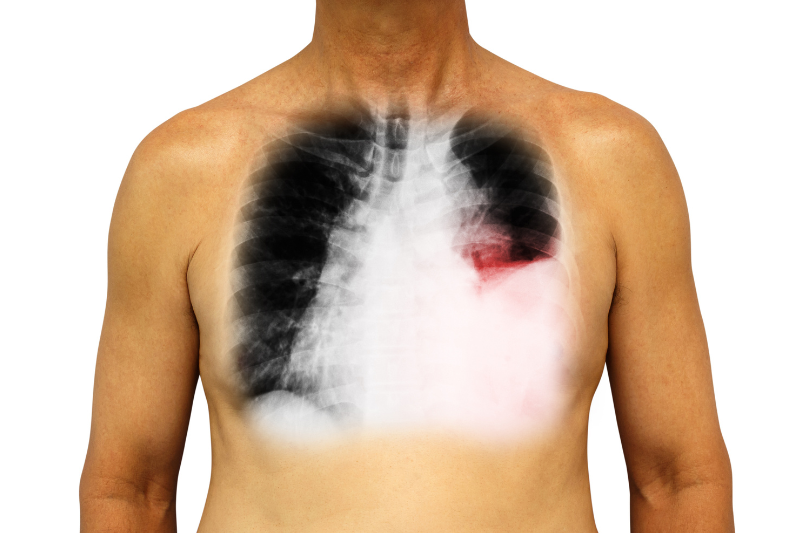What is Lung Cancer and What are Your Treatment Options in Dallas-Fort Worth Metroplex
Lung cancer is a type of cancer that originates in the lung tissue. In the US, lung cancer is the second most common cancer in both men and women, with an estimated 238,340 new cases and 127,070 deaths in 2022. Smoking is one of the lead causes of lung cancer, but other factors such as genetics and environmental exposure can significantly increase risk of developing lung cancer.
Early Detection and Prevention of Lung Cancer
Since smoking is the leading cause of lung cancer, the best form of prevention is to minimize exposure to all forms of tobacco. However, given that nicotine is such an addictive substance and continues to be widely available legally, it is difficult to completely remove it from our society. Therefore, early detection now plays an important role as well. Lung cancer can sometimes be seen many years earlier in the form of lung nodules. Usually, patients with a significant history of smoking can qualify for a screening test called low-dose computed tomography (LDCT). This type of CT scan monitors for early signs of development of lung cancer and can help us detect it and treat it much earlier.

The USPSTF recommends annual screening for lung cancer with LDCT in those between the ages of 50 to 80 years who have a 20 pack-year smoking history and are current smokers or have quit within the past 15 years. Once a nodule has been found, then it needs to be monitored with annual scans. If the nodule is found to be growing, then it will have to undergo additional studies such as a PET-CT or biopsy of the lung. We have many patients in our center at Texas Oncology in Fort Worth who are being monitored by our lung specialists for early signs of lung nodule development. If you have a history of smoking, schedule a consultation today to see if you would qualify for ongoing screening.
Patients can also present with symptoms that might be concerning for lung cancer. These symptoms can include increasing shortness of breath, chest pain, or excessive coughing of sputum or blood. The first step is usually to obtain a lung x-ray and depending on the findings of that x-ray, we might need to obtain a CT scan of the chest or other studies. If concerning findings such as a lung mass, enlarged lymph nodes, pleural effusion (fluids in the lung linings) are seen, then additional steps such as a biopsy might be indicated. Given our expertise in treating many different types of lung cancer, come and see us if you have a recent biopsy concerning for lung cancer.
Lung Cancer in Texas and Dallas Fort Worth Area
Texas as a state has a high incidence of lung cancer and ranks 10th in the nation with 49.8 cases per 100,000 people. However, we rank 27th in the nation for survival at 22.5%. And sadly, we rank last when it comes to treating lung cancer, surgery, and screening for lung cancer. However, we are here to change that. We strive everyday to create a center of excellence in treatment of lung cancer. So call our office today to schedule a consultation with Dr. Akhtari and the needed next steps for best possible outcomes if you live in the DFW metroplex with a recent diagnosis of lung cancer.

What are Different Types of Lung Cancer
There are two main types of lung cancer: small cell lung cancer (SCLC) and non-small cell lung cancer (NSCLC).
- Small cell lung cancer (SCLC) is usually found in those with history of heavy smoking. This type of cancer tends to spread quickly and is often advanced at the time of diagnosis.
- Non-small cell lung cancer (NSCLC) is more common and is at times more slow growing, although it can still be quite aggressive. There are three main types of NSCLC:
- Adenocarcinoma is the most common type of NSCLC, accounting for about 40% of all lung cancer cases.
- Squamous cell carcinoma, another type of NSCLC also known as epidermoid carcinoma, accounts for about 30% of all lung cancer cases and tends to occur in the central part of the lungs.
- Large cell carcinoma accounts for about 10% of all lung cancer cases.
Treatment Options in Non-Small Cell Lung Cancer
Treatment of Stage 1 NSCLC
Stage I NSCLC is relatively small in size and in earlier phases of growth. It has by definition not spread to lymph nodes, other parts of the lungs or other organs. Treatment of stage I NSCLC has traditionally consisted of lobectomy, which involves surgically removing a whole lobe of the lung.
More recently a new and advanced radiation technique called stereotactic body radiation therapy (SBRT) has been developed which is quite effective at treating stage I NSCLC. This type of therapy uses high doses of radiation in a few treatments to kill cancer cells. This type of pinpoint radiation uses ablative doses of radiation in a few sessions (between 3-5) to obliterate the tumor while for the most part sparing the lung. It is a non-invasive procedure and very well tolerated with amazing outcomes. Dr. Akhtari has extensive experience and expertise with this advanced procedure and has treated hundreds of lung cancer patients in DFW area. If you or a loved one have been diagnosed with stage I NSCLC, call today for a consultation regarding SBRT.
Treatment of Stage 2 NSCLC
Stage 2 NSCLC is more advanced than stage 1, but only advanced locally and has not spread to distant areas. Usually it is a tumor either larger in size up to 5 cm or spread to local lymph nodes. This stage of NSCLC can be either treated with surgery or combination of chemotherapy and radiation (chemoradiation) if patients are not a surgical candidate. If there is residual disease or more advanced disease found at the time of surgery then patients might need to receive radiation after surgery as well.
This type of radiation is usually called IMRT (Intensity Modulated Radiation Therapy). Although still very accurate, because it has to treat a larger area this type of radiation is not as pinpoint as SBRT. This type of radiation is usually done over 6-6.5 weeks, daily Monday-Friday. The treatments usually last between 30-45 minutes. Dr. Akhtari has treated hundred of patients in the Dallas-Fort Worth metroplex with this stage of NSCLC. If you have been diagnosed with this stage of NSCLC, call today to schedule a consultation or get a second opinion.
Treatment of Stage 3 NSCLC
This stage of NSCLC is even more advanced than stage 2 and usually indicates that tumors have grown to 7 cm, invading adjacent organs, or spread to more distant lymph nodes. The treatment of stage 3 NSCLC is chemoradiation. This is also treated with chemoradiation over 6-6.5 weeks. Dr. Akhtari has significant expertise in treating this stage of NSCLC. Our state of the art equipment in the radiation department, diagnostic equipment, and infusion suite provide us with the opportunity to provide both the radiation and chemotherapy portion in one convenient location. Call today to schedule a consultation with Dr. Akhtari and learn more about your treatment options.
Treatment of Stage 4 NSCLC
This is the most advanced stage of NSCLC and indicates that the cancer has spread to other organs. Traditionally, this stage of NSCLC was considered fatal, with chemotherapy being the only option and for palliative purposes only. However, with the advent of modern treatments such as immunotherapy, targeted small molecular inhibitors, and SBRT and stereotactic radiosurgery, some patients with a limited number of metastases can be treated aggressively with hopes for long term control of the cancer or even cure. For example, if a person has only one single area of spread to the brain, he or she is considered what we would call oligometastatic disease. Oligo means few, and patients with limited areas of disease are candidates for aggressive treatment. The patient in the above example can be treated with chemoradiation to the lung and stereotactic radiosurgery to the brain with hopes of long duration of being disease free and even potentially cure.
Each patient’s case can be different depending on their own medical and tumor stage and characteristics. The above information does not constitute medical advice. Please consult with your own physician what treatment is appropriate for you. If you are in the Dallas-Fort Worth metroplex, call today to schedule an appointment with Dr. Akhtari and discuss which treatment options fit your special and unique situation.
Treatment Options in Small Cell Lung Cancer
Traditionally, SCLC treatments have been divided to two different groups, those for what is called Limited Stage Disease and those for Extensive Stage Disease.
Limited Stage is disease confined to the chest and that can be treated with combination of chemotherapy and radiation therapy (chemoradiation). The radiation type in this scenario is usually IMRT and typically lasts 6-6.5 weeks.
Extensive stage disease is disease that has spread to outside the chest. This is usually treated with chemotherapy and immunotherapy (chemoimmunotherapy) but sometimes radiation therapy is used as well. The radiation in these scenarios is usually 3D conformal radiation therapy (3D-CRT) or IMRT, depending on the situation.
In SCLC, the brain is also an organ at risk of spread of disease. In the past, most patients would be treated with what is called prophylactic cranial irradiation (PCI). This is a procedure that treats the whole brain with radiation before there is any cancer there in a prophylactic manner, to prevent future spread of cancer there. However, more and more patients are now being monitored with serial MRIs and undergoing treatment later if they develop cancer there, with either whole brain radiation therapy (WBRT) or stereotactic radiosurgery (SRS).
Dr. Akhtari also has treated numerous patients with SCLC in the Dallas-Fort Worth metroplex. Since every patient’s situation is unique, call us today to schedule a consultation.